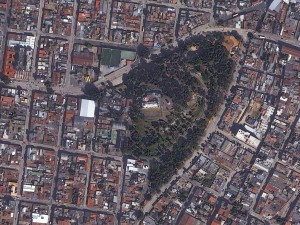The Republic of Guatemala is a former Mayan civilization in Central America or the southernmost portion of the continent of North America. Bordered by Mexico, Belize, Honduras, El Salvador and the Caribbean, Guatemala is what is known as a biodiversity hotspot, a region with diverse biological resources that are often threatened by human interference. To qualify as a biodiversity hotspot, according to Norman Myers, a pioneer in research on environmental refugees, a region must contain at least 1,500 species of vascular plants and have lost at least 70% of its primary vegetation. Guatemala has the largest forested region in Mesoamerica; and the second largest contiguous forest, behind the Amazon, in the Americas. Due to the wealth of flora coupled with the country’s decade-long environmental management issues, there has been an uptick in international support to conserve Guatemala’s natural resources.
 El Palacio Nacional de la Cultura, or the National Palace, of Guatemala City is considered to be a work of art in the architecture world. Built to withstand earthquakes, it also withstood the rumblings of the local bureaucracy for years. 60-cm color QuickBird imagery comes courtesy of DigitalGlobe. This data was captured December 14th, 2013, and has been enhanced by Apollo Mapping.
El Palacio Nacional de la Cultura, or the National Palace, of Guatemala City is considered to be a work of art in the architecture world. Built to withstand earthquakes, it also withstood the rumblings of the local bureaucracy for years. 60-cm color QuickBird imagery comes courtesy of DigitalGlobe. This data was captured December 14th, 2013, and has been enhanced by Apollo Mapping. La Iglesia Cerrito del Carmen (Carmen Hill) is a church that sits in the Valle de la Vaca (Valley of the Cow) and is known for its sober architecture; which is quite distinct from the National Palace in that it stresses utilitarianism, not physical beauty. 60-cm color QuickBird imagery comes courtesy of DigitalGlobe. This data was captured December 14th, 2013, and has been enhanced by Apollo Mapping.
La Iglesia Cerrito del Carmen (Carmen Hill) is a church that sits in the Valle de la Vaca (Valley of the Cow) and is known for its sober architecture; which is quite distinct from the National Palace in that it stresses utilitarianism, not physical beauty. 60-cm color QuickBird imagery comes courtesy of DigitalGlobe. This data was captured December 14th, 2013, and has been enhanced by Apollo Mapping.Guatemala City, or La Nueva Guatemala de la Asunciôn as it is formally referred to, is the capital of Guatemala and is home to just over 1 million residents. The capital has been in the news recently for an active lava flow emanating from the Pacaya volcano which is in close proximity to the city. In mid-January, the lava flow measured 600 meters wide and some 3 kilometers long, and it caused nearby inhabitants to relocate from the crater. Pacaya is on record as having first erupted 23,000 years ago, and is believed to have erupted more than twenty times since then. Just weeks before this eruption, there was volcanic activity in the Aleutian Islands, though there is not any conclusive evidence that the reactions are linked.
On a lighter note, and one more praiseworthy of the capital and country’s rich history, it was also recently reported that Guatemala City will soon host The Museum of Mayan History. Construction is set to begin in 2015 and the museum should open in 2017; it will be crafted in the spirit of Mayan architecture. The 60,000 square foot structure will be located alongside a modern art and a children’s museum. These edifices will face L’Aurora Park, the city’s largest recreational area.
While the new museum will shed light on the country’s rich history, the city is full of other beautiful buildings built in the last several centuries. One of the more modern is the National Palace. Construction on the Palace began in 1939 and was completed in 1943; the building was once home to the government’s executive branch. The 350-room structure was built by laborers from the prison; though it is likely they never were invited for a thank you dinner. Once decorated with beautiful, ornate stained glass windows signifying the ‘ten virtues of a good nation,’ the windows were shattered in 1980 when a car bomb went off outside. It also previously withstood a 7.5 magnitude earthquake. Still standing, the building is a tourist’s heaven, and is also proof of the superior craftsmanship of the Guatemalans – even when it isn’t by choice!
Nestled in the mountain valley, Valle de la Ermita, Guatemala City is a beautiful municipality in an equally beautiful country. A worthwhile stop on our tour of this Small World, it is also home to a thriving art scene as can be seen by its premiere film festival, Festival Icaro, a sort of Cannes of the south. With its cultural heritage and commitment to environmental and historical preservation, Guatemala City is surely a city set to make its mark on the international stage of progress.
Justin Harmon
Staff Writer


Leave a Reply